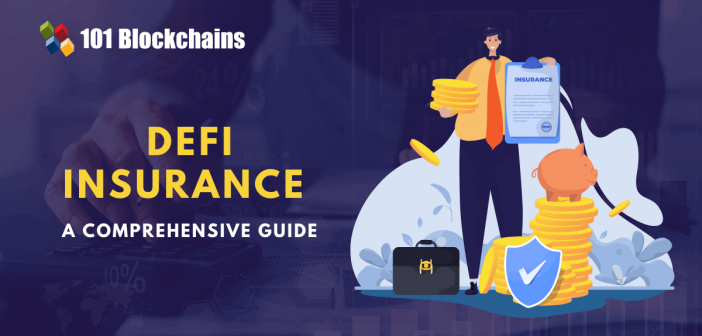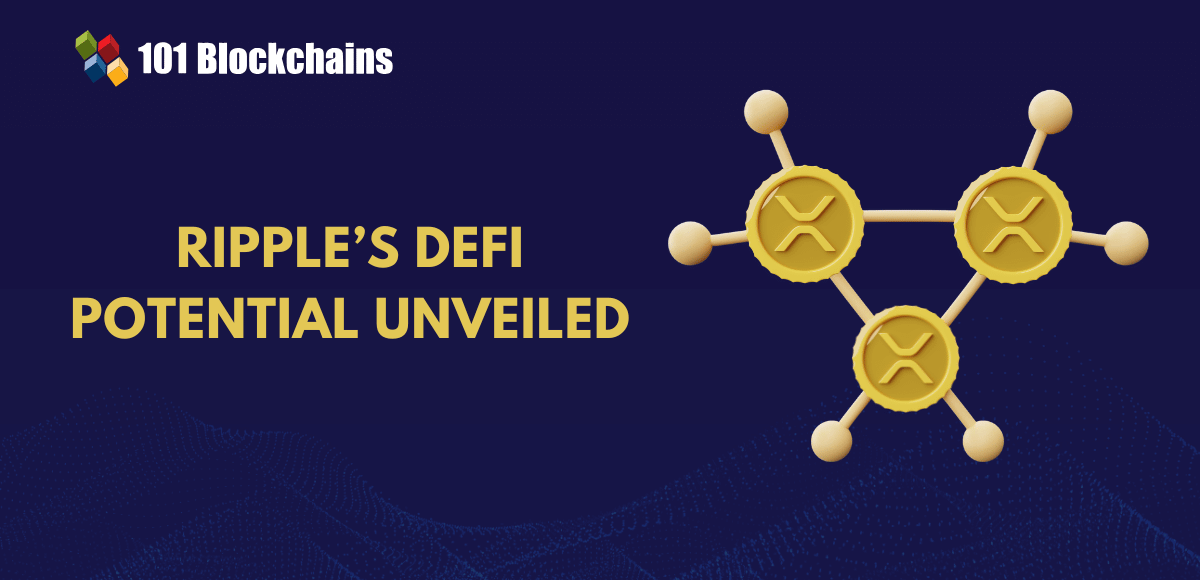Learn how blockchain truly works, master key definitions, and uncover what makes smart contracts so "smart." Dive into the fundamentals, gain valuable insights, and start your blockchain journey today!

- Decentralized Finance
Georgia Weston
- on April 08, 2022
DeFi Insurance – Simply Explained
The world is gradually turning towards crypto, unlike ever before, with the evolution of decentralized finance or DeFi. Decentralized finance promises a financial system with profound improvements such as limited dependency on centralized parties and improved efficiency. At the same time, the possibility of hacking attacks leading to the loss of DeFi assets has emerged as a formidable concern in recent times. This is where you would find DeFi insurance as a vital tool for protecting your digital assets. So, what is different in insurance for DeFi? How does it work? Let us find the answers to all these questions in the following introductory guide on insurance in DeFi.
Want to learn and understand the scope and purpose of DeFi? Enroll Now in Introduction to Defi Course
The Staggering Growth of DeFi
Decentralized Finance or DeFi has the potential to shape the crypto world in new ways. As a matter of fact, the growth of DeFi in recent times has shown how the future of finance will depend a lot on decentralization. DeFi offers freedom from centralized intervention in finance alongside improving transparency and flexibility in accessing financial services. The total value of assets locked in DeFi protocols and solutions has exploded radically since the onset of 2020.
Interestingly, the growth from $670 million to around $40 billion in one year set the jump at almost 6000%. As of now, the TVL of the whole DeFi ecosystem is somewhere around $255 billion. For a term that was coined in August 2018, DeFi has undoubtedly registered some astonishing growth numbers. However, the roads in DeFi are not as simple as they seem now.
Want to understand the best ways to use DeFi development tools like Solidity, React, and Hardhat? Enroll now in the DeFi Development Course!
Dark Side of DeFi
The continuous growth of DeFi has also led to the rise in many types of vulnerabilities. DeFi solutions have been subjected to protocol exploits alongside hacks. In this case, decentralized finance insurance becomes a formidable priority for anyone interested in DeFi. Hacking attacks on 15 different DeFi platforms in 2020 resulted in a loss of around $120 million. Subsequently, the loss for DeFi due to hacks and scams amounted to almost $10 billion in 2021.
You can notice that DeFi is an exciting yet unexplored dimension in crypto. The use of smart contracts and decentralized protocols increases the possibilities of hacks and exploits, resulting in more losses for users. For example, flash loan hacks can exploit vulnerabilities in smart contracts to drain millions of dollars from liquidity pools. Therefore, DeFi users have confirmed the need for DeFi insurance to stay safe against capital losses. As a matter of fact, insurance in DeFi is one of the critical factors for the widespread adoption of DeFi alongside awareness and regulation.
Want to explore in-depth about DeFi protocol and its use cases? Enroll now in DeFi Intermediate Level Course
What is DeFi Insurance?
One of the first aspects in any account of DeFi insurance explained clearly is its definition. The definition of insurance in DeFi is nothing different from regular insurance. The concept of insurance in DeFi basically focuses on insuring yourself against the losses due to events in the DeFi ecosystem.
For example, let us assume that you have some amount of capital locked in a DeFi protocol or platform. You know that any compromises in the DeFi platform can lead to a loss of your capital. Therefore, you can choose DeFi insurance as a safeguard against the risk of losing your capital on the DeFi platform.
You can visit an insurance provider for DeFi assets and pay a specific amount to obtain coverage in the event of losing your capital on the platform. The premium you have to pay in decentralized finance insurance depends on different factors, including the cover type, provider, and duration. However, DeFi users must also develop a clear understanding of different types of events for which they can buy coverage.
Just like regular insurance plans, you should know what you are insuring yourself against in the DeFi world. Some of the best DeFi insurance solutions are suitable for attacks on DeFi protocols, stablecoin price crashes, and exchange hacks. In addition, you can also explore insurance solutions in DeFi for covering smart contract failures.
Learn the fundamentals of Decentralized Finance (DeFi) with DeFi Flashcards!
Working of the DeFi Insurance
After a clear overview of the definition of insurance in DeFi, it is important to dive deeper into its work. One of the foremost aspects of “How does decentralized insurance work?” rests on decentralization. The basic objective of insurance in DeFi is more or less the same as insurance in the scope of traditional finance. Insurance in DeFi protects users from losses in return for a specific premium amount according to the size of their holdings and the platforms.
Generally, a multinational insurer issues and underwrites a traditional insurance policy. However, DeFi insurance projects might lose their essence upon avoiding decentralization. Rather than purchasing insurance coverage from one specific individual or company, you can purchase coverage from a decentralized pool of insurance providers. Interestingly, any individual or company can work as an insurance provider by locking up capital in the decentralized capital pool. The individual or company providing capital to the pool can qualify as a liquidity provider.
The liquidity providers also referred to as underwriters, serve as the main agents in DeFi insurance protocols. They provide capital in the pools in return for a share of the premiums. The next important actors in the working of insurance in DeFi include the governance token holders and claims assessors. They take on the responsibility for voting on claims and modifications to the protocol. Another important component of decentralized finance insurance is the claimants, who purchase the insurance premiums.
As you can notice, every player has a distinct role in the overall scheme of insurance in DeFi. Staking in DeFi insurance projects, according to the underlying protocol, can serve as a promising pursuit for accessing a regular income stream from insurance premiums. On top of it, the rewards of native governance tokens also make insurance in DeFi more lucrative. Coverage providers can choose the type of events and the protocols on which they want to offer coverage. On the other hand, liquidity providers or coverage providers also have to face exposure to risk.
Want to understand how TradFi and DeFi will be connected in the near future, Watch our on-demand webinar on Bridging Traditional Finance With DeFi
Is DeFi Insurance Necessary?
The answer to “How does decentralized insurance work?” provides a solid foundation for validating its necessity. When you take a look at the traditional insurance market, it has a value of more than $6 trillion now. The staggering growth of DeFi has resulted in a massive influx of institutional capital into the DeFi space. At the same time, the risks of hacks, exploits, and thefts in the DeFi landscape continue growing every day.
As a result, DeFi insurance is more than just a necessity for many investors in the DeFi space today. Investors can explore different types of packages with customizable options and flexible liquid coverage. You can think of insurance in DeFi as a favorable strategy for hedging your risk and safeguarding against events beyond your control. However, it is also important to reflect on the feasibility of the premium for insurance in DeFi.
Many of you may wonder whether the premiums are justified for the coverage offered in the best DeFi insurance package. The premium helps users in safeguarding the value of their digital assets by exploiting smart contracts. One of the common expectations associated with DeFi insurance is that you pay more for riskier protocols. For example, the premium on Nexus for insuring 10 ETH is around 0.1281 ETH for the Curve Finance protocol. The same platform charges a premium of 2.18 ETH on 10 ETH in the Acropolis Delphi protocol.
While the insurance premium seems like a fair price for the security of your DeFi assets, many people have doubts about the cover received through DeFi insurers. Generally, most insurers pay out for technical issues in smart contracts, albeit on a completely discretionary basis. You should also note that decentralized finance insurance protocols don’t offer coverage for many issues in different layers of a DeFi protocol. At the same time, the lack of a secondary market for trading can limit the scalability of insurance protocols.
We have an insightful webinar session for DeFi And The Future Of Finance. Watch now our on-demand webinar on DeFi And The Future Of Finance
Verification of Claims in DeFi Insurance
Another significant highlight in any discussion on DeFi insurance projects would draw the limelight toward the verification of claims. Who has the authority to determine the validity of a claim? In most cases, the community itself takes care of claims verification through the DAO or Decentralized Autonomous Organization structure. As a result, native token holders can get governance rights in the insurance protocol and participate in voting for claims verification. However, community voting is not always applicable in the verification of claims.
Automatic verification of claims in some of the best DeFi insurance solutions through oracles is also another proven approach. Oracles are basically decentralized information mechanisms for the verification of external data. You can set up oracles for accurately tracking the outcome of different events alongside distributing the information throughout the internet. Therefore, DeFi insurance protocols can minimize the possibility of a dispute in claims.
Want to explore an in-depth understanding of security threats too in DeFi projects? Enroll now in DeFi Security Fundamentals Course
DeFi Insurance Projects
With a detailed overview of the basics of decentralized finance insurance and its working, you must be eager to find some top insurance platforms and protocols in this field. Here is an outline of some of the best insurance projects in the domain of DeFi.
-
Solace

Solace is a decentralized insurance protocol for helping market makers and liquidity providers stay safe from risks emerging from smart contract exploits. The decentralized insurance protocol focuses largely on high capital efficiency, automated claims processing, and intelligent risk assessment.
-
Unslashed

Unslashed is another top entry among top DeFi insurance projects in the market right now. It provides coverage for a broad range of products, protocols, and markets. The platform ensures almost instant liquidity for insurance buyers alongside risk underwriters. On top of it, the insurance protocol also ensures an unbiased claims process.
-
Nexus Mutual

Nexus Mutual is one of the popular DeFi insurance platforms for creating a mutual risk-sharing pool on the Ethereum blockchain. The platform offers three distinct types of covers, including a Yield Token Cover, a Custody Cover, and a Protocol Cover.
-
Insure DeFi

The next addition among insurance protocols in DeFi refers to Insure DeFi, which safeguards the crypto portfolio of users with insurance.
The platform provides coverage against scammers, devaluation, and stolen funds.
-
Bridge Mutual

Another notable mention among decentralized finance insurance solutions refers to Bridge Mutual, a decentralized insurance platform. The platform enables users to purchase or sell coverage for different crypto assets and protocols. Most important of all, you can ensure safeguards for your assets from stablecoin crashes, hacks, and exploits.
Build your identity as a certified blockchain expert with 101 Blockchains’ Blockchain Certifications designed to provide enhanced career prospects.
Challenges for DeFi Insurance
The DeFi insurance industry is still in the stages of development. On the other hand, the billions locked in DeFi protocols present some promising opportunities for growth of insurance in DeFi. However, the adoption of insurance in DeFi is quite slow, with only 2% of all DeFi assets under insurance coverage. Here are some of the prominent challenges for the future of decentralized insurance.
-
Ambiguity Regarding DeFi Risks
One of the foremost aspects in the working of DeFi insurance explained clearly focuses on the need for an underwriter. In addition, the difficulty in estimating DeFi risks creates ambiguities in pricing insurance premiums.
-
Underwriters Receive Only Insurance Premiums
Liquidity provides serving as underwriters only receive yields in the form of insurance premiums. Traditional insurance markets re-invest the collateral in safe products for generating yields. However, there is no specific consensus on safe investments for pooled funds in DeFi.
Learn about the fundamentals of DeFi, how it works, elements of the DeFi ecosystem, and the interplay between blockchain and DeFi through this Decentralized Finance (DeFi) E-book
Final Words
The final impression regarding DeFi insurance suggests that it can be a massive force in the DeFi landscape. Many companies have been trying to break into the DeFi space, albeit with formidable apprehensions regarding the safety of their capital. On the contrary, the growing complexity and variety of hacks and exploits in the DeFi space point out the immediate necessity for adopting decentralized insurance. From the looks of it, decentralized finance insurance does not rely on purchasing insurance coverage from one individual or company.
On the contrary, a group of liquidity providers contributes capital to a decentralized pool of funds that would provide coverage to DeFi users. The underwriters or liquidity providers can receive insurance premiums as the rewards for their stake in the pool. However, decentralized insurance has a long way to go and many challenges to overcome. Learn more about DeFi and decentralized insurance right now.
*Disclaimer: The article should not be taken as, and is not intended to provide any investment advice. Claims made in this article do not constitute investment advice and should not be taken as such. 101 Blockchains shall not be responsible for any loss sustained by any person who relies on this article. Do your own research!



![30+ Best Decentralized Finance Applications [Updated] best decentralized finance (DeFi) applications](https://101blockchains.com/wp-content/uploads/2020/10/decentralized-finance-applications.png)

